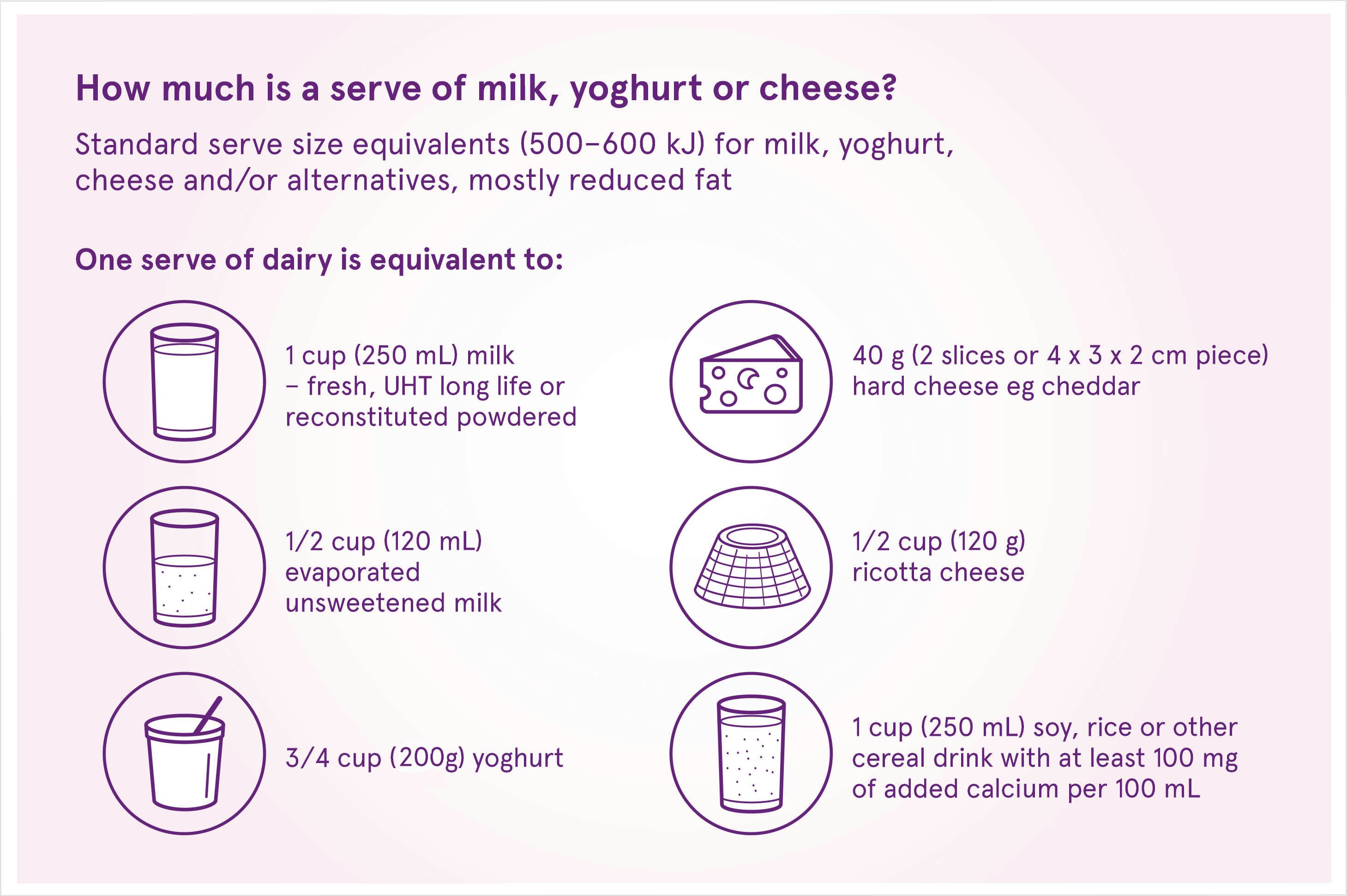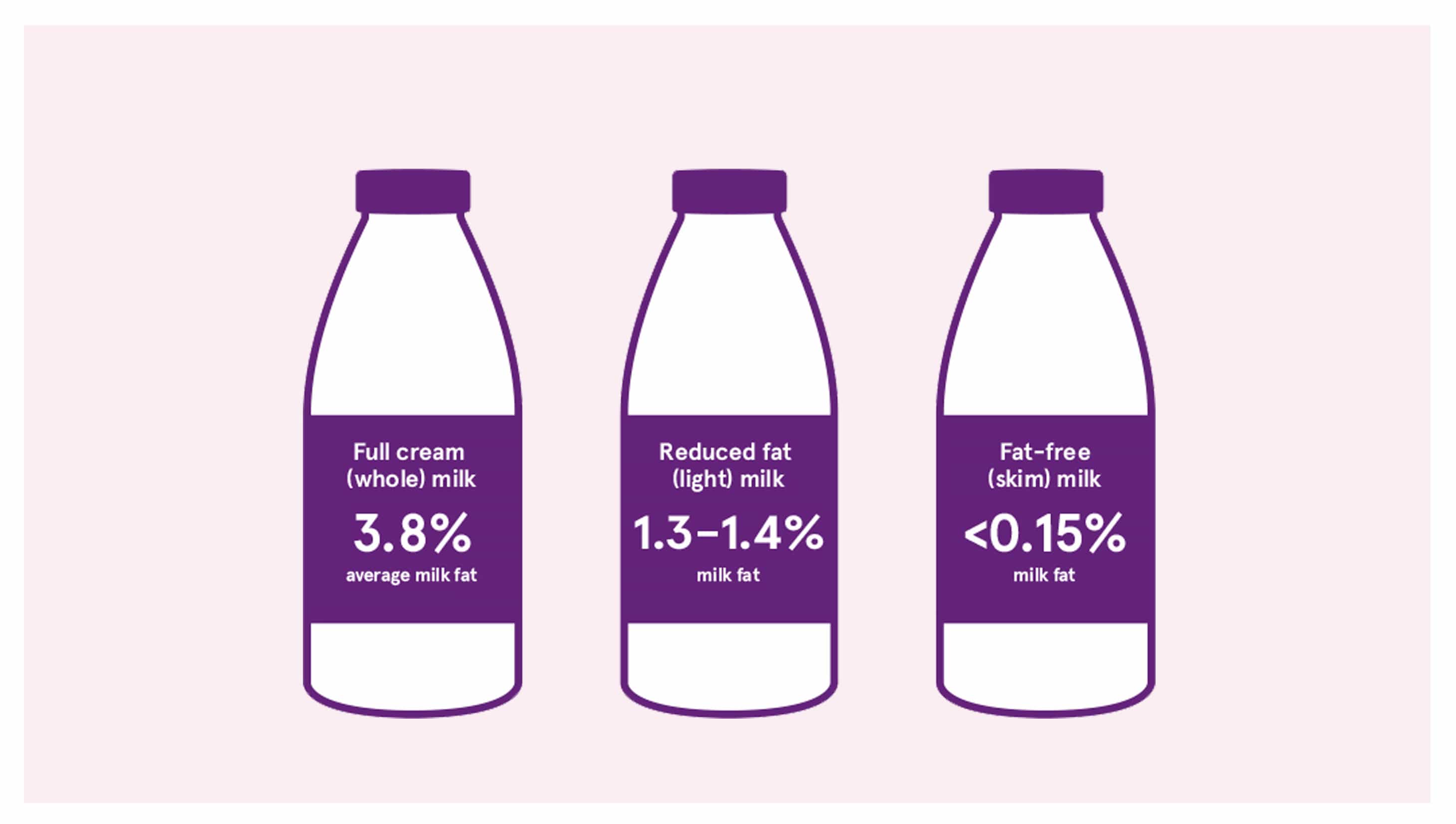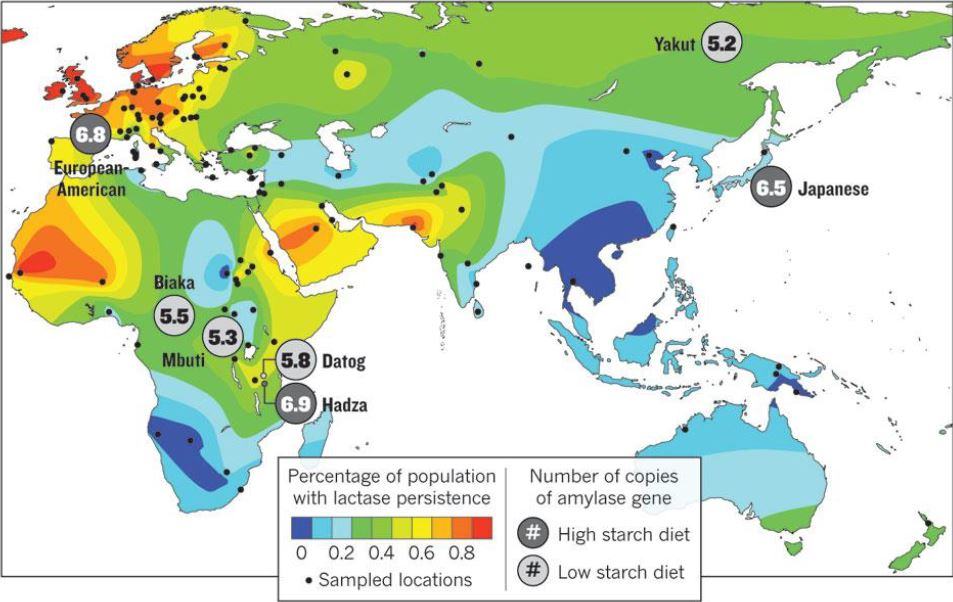Milk consumption – what do the guidelines say?
The current Australian Dietary Guidelines1 recommend the consumption of reduced fat milk and dairy products. However, a recent comprehensive review of the data on the relationship between the consumption of dairy fat and high-fat dairy foods, obesity and cardiometabolic disease came to some surprising conclusions people who consume full-fat dairy are no more likely to develop cardiovascular disease and type 2 diabetes than people who consume exclusively low-fat dairy. The review also found that consumption of full-fat dairy may actually be better for avoiding weight gain – in 11 of 16 studies, high-fat dairy intake was associated with lower body fat levels and lower long-term weight gain.2
Are Australians meeting the Australian Dietary Guidelines for dairy and dairy alternatives?
In short, the answer is no…
A comparison of the usual number of serves consumed compared with Australian dietary guideline recommendations suggests that only around 10% of Australians consumed sufficient dairy products and/or alternatives to meet the recommendation.3 Children aged 2–8 years were most likely to meet the recommendation (43%), while only 6.4% of people aged 9 years and over were able to do so, including less than 1% of people aged 71 years and over.3
Only around 1 in 10 Australians consume sufficient dairy products and/or alternatives to meet guideline recommendations. 3
- On average, Australians aged two years and over consumed 1.5 serves of milk, yoghurt, cheese and alternatives per day, well below the minimum recommended intake for all population groups which range from 2.5–4 serves1,3
- Only 1 in 1000 women aged 50 years and over was able to meet the recommended 4 serves1,3
- From the age of three years onwards, at every stage of childhood, more and more are consuming less than the recommendation. By the time children reach 14–18 years, less than 3 in 100 boys and only 1 in 200 girls are consuming enough dairy foods to meet the recommendation1,3
Milk, yoghurt, cheese and alternatives: Recommended number of usual serves, median serves consumed and proportion meeting recommendation
| Age group (years) | Recommended minimum Servesa | Median servesb | Proportion meeting recommendation % |
|||
| Males | Females | Males | Females | Males | Females | |
| 2-3 | 1½ | 1½ | 1.9 | 1.7 | 70.0 | 60.3 |
| 4-8 | 2 | 1½ | 1.5 | 1.3 | 26.3 | 40.2 |
| 9-11 | 2½ | 3 | 1.5 | 1.5 | 12.0 | 3.9 |
| 12-13 | 3½ | 3½ | 1.7 | 1.4 | 3.9 | 1.8 |
| 14-18 | 3½ | 3½* | 1.6 | 1.1 | 2.5 | 0.5 |
| 19-50 | 2½ | 2½* | 1.6 | 1.3 | 13.9 | 6.0 |
| 51-70 | 2½ | 4 | 1.2 | 1.2 | 5.4 | 0.1 |
| 71+ | 3½ | 4 | 1.2 | 1.2 | 0.5 | 0.1 |
Adapted from Australian Health Survey: Consumption of food groups from the Australian Dietary Guidelines. 2016.3
a Australian Dietary Guidelines. 2013.1
b From non-discretionary sources.
*For pregnant women up to 18 years of age the recommended usual intake of dairy is 3½ serves and 4 serves for breastfeeding women of the same age. For pregnant and breastfeeding women 15–50 years, the recommended usual intake of dairy is 2½ serves. However, both the pregnant and breastfeeding populations have been excluded from this analysis.
How much is a serve of milk, yoghurt or cheese?

Adapted from NHMRC Modelling System. 2011.4
![]()
Dairy milk
Full cream cows’ milk accounts for more than half of all dairy milk sold in Australia today. However, there are a number of other dairy milks available including reduced-fat or fat-free, lactose-free, A1 beta-casein-free and fortified cows’ milks, as well as non-cows’ milk dairy milks.
![]()
Non-dairy milks
Non-dairy milks derived from soy, cereals or nuts may be suitable for people unable to consume dairy milk for medical reasons, including allergy or intolerance. However, many plant-based milk alternatives may not be fortified with sufficient calcium and other nutrients inherently present in cows’ milk.
Dairy milk
The different fat profiles of dairy milk

Full cream (whole) milk
In recent years full cream milk has had a resurgence in popularity and accounts for more than half of all dairy milk sold in Australia today. Many people enjoy the rich and creamy texture that milk fat provides: full cream milk, on average, contains 3.8% milk fat and must contain at least 3.2% fat as specified by the Australian Food Standards Code.1 Full cream milk is recommended for children under two years of age due to their higher energy requirements.2
With at least 8 g of fat per cup (250 mL) of full cream milk, for those who regularly consume two to three serves of full fat dairy milk each day this will result in the consumption around 20 g of extra fat to their diet. This may be too many extra calories for some people and for those for whom total fat intake is a concern for other reasons – in such cases, reduced-fat milk is the recommended choice.
Light or reduced-fat milk
Most brands of light milk contain 1.3–1.4% fat. The nutritional benefits of light or reduced-fat milk are very similar to full cream milk. The Australian Dietary Guidelines recommend low fat varieties for individuals aged two years and older, as full fat varieties can increase the saturated fat content of the diet.
Fat-free or skim milk
Fat-free or skim milk must contain less than 0.15% fat and at least 3% protein as specified by the Australian Food Standards Code.1 Skim milk has the lowest total fat and saturated fat content of all cows’ milk varieties. As a result of removing the fat, the concentration of calcium, protein, lactose and some other nutrients is marginally higher than in full cream (whole) milk. The key benefit of skim milk is the avoidance of fat.
Skim milk is a good choice for people who need to manage their total fat intake, or for those who want to enjoy the nutritional benefits of dairy but with fewer kilojoules.
Organic milk
Organic milk comes from organically farmed animals fed a variety of foods natural to their diet, and allowed free movement and natural light and ventilation while inside.
Lactose-free milk
Lactose is the carbohydrate or disaccharide that naturally occurs in mammalian milk, including human breast milk. In normal digestive function, the lactase enzyme in the small intestine breaks down the lactose so that its constituent monosaccharides (galactose and glucose) can be absorbed readily into the circulation. However, in those who are lactose intolerant, intact lactose which has escaped hydrolysis in the small intestine transits to the large intestine where it is fermented by bacteria, causing uncomfortable symptoms including gas, bloating and diarrhoea.
An estimated 65% of adults experience gradually decreasing production of intestinal lactase after weaning. Continued production of lactase throughout adult life (lactase persistence) is a genetically determined trait and is found at moderate to high frequencies in some populations, including many European populations and also in those who are of European descent.3
Exogenous lactase sources
Patients may also prefer or find it more convenient to use an exogenous lactase source when consuming lactose containing milk. Lactase enzyme can be purchased from many pharmacies so that patients with true lactose malabsorption can enjoy their favourite lactose-containing milk without experiencing the gastrointestinal symptoms associated with lactose malabsorption. One example is LactoFree® tablets which are taken just before consuming lactose-containing milk to help break down the lactose.
It is estimated that 65% of adults experience gradually decreasing production of intestinal lactase after weaning.4
Lactose-free milk is a suitable alternative to regular cows’ milk for people who are genuinely lactose intolerant. Lactose-free milk has most of the lactose hydrolysed or removed, making it a good option for those with lactose intolerance.

Adapted from NHMRC Modelling System. 2011.
A1 beta-casein-free cows’ milk
a2 Milk™ is the logical choice for those who wish to avoid the A1 beta-casein protein in regular cows’ milk. Learn more about a2 Milk™
Beta-casein is one of the main cows’ milk proteins, comprising around 30% of total protein, and is present as one of two major genetic variants: A1 beta-casein and A2 beta-casein. A2 beta-casein is recognised as the original beta-casein gene variant. The A1 beta-casein protein is the result of a mutation that arose in the A2 beta-casein gene in European herds several thousand years ago.7-10
Australian research suggests the A1 protein in ordinary cows’ milk might cause digestive discomfort in some individuals.11 Regular cows’ milk contains a mixture of A1 and A2 beta-casein. Existing and emerging research is
exploring the possible health impacts of cows’ milk A1 beta-casein. a2 Milk™ contains only the A2 beta-casein protein. .
Modified cows’ milk
Modified cows’ milk includes variants which are fortified with added vitamins to cater for a range of dietary requirements, including vitamin D. Vitamin D is essential for the body to absorb calcium effectively, which is important for bone health and muscle function, and for preventing conditions such as osteoporosis. The main source of vitamin D is exposure to sunlight.
Most people only get a small amount of vitamin D from their diet (5–10%). Foods which are good sources of vitamin D include fatty fish, and fortified margarine and milk. 12-14
Groups at increased risk of low vitamin D include people with naturally very dark skin and people who have very low exposure to sunlight.
As it is not possible to achieve sufficient vitamin D from the diet alone, getting adequate sunlight during the day is important to meet the body’s requirements.
Refer to the Cancer Council Australia Position statement on the risks and benefits of sun exposure for daily sunlight exposure recommendations.
Toddler milks
Toddler milk is specially designed to supplement the diet of toddlers when their intake of energy and nutrients may not be adequate. Toddler milks are fortified with age-appropriate nutrients to help support growth and development.
All toddler milk brands have added vitamins and minerals, and some have a higher fat content than regular cows’ milk. They are not a necessary addition to a toddler’s diet if the toddler is eating normally and able to get all of his/her required nutrients by eating a range of nutritious foods.
Nutrients in toddler milk drink compared to full cream cows’ milk
|
Per 100 mL |
Full cream cows’ milka | Toddler milk drink
(mean values of top 3 brands) |
| Energy (kJ) | 293 | 288 |
| Protein (g) | 3.5 | 2.5 |
| Fat (g) | 3.5 | 2.6 |
| DHA (mg) | 0 | 13.3 |
| Alpha linolenic acid (mg) | not advertised | 94.0 |
| Carbohydrate (g) | 6.3 | 8.2 |
| Lactose (g) | 6.3 | 7.2 |
| Vitamin C (mg) | 0 | 10.6 |
| Vitamin D (µg) | 0.536 | 0.78 |
| Calcium (mg) | 117 | 115 |
| Potassium (mg) | 150 | 0.0 |
| Iron (mg) | NONE | 1.5 |
| Iodine (µg) | NONE | 16.6 |
aCows’ milk values per 100 mL taken from Food Standards Australia New Zealand (FSANZ) NUTTAB database and Foodworks supermarket.
Non-dairy milk
Per 100 mL, unfortified soy milk contains only 13 mg of calcium while cows’ milk contains 107 mg.
Non-dairy milk types
Non-dairy milks derived from soy, rice, oat or nuts may be suitable for people unable to consume dairy milk for medical reasons, including allergy or intolerance. However, many plant-based milk alternatives may not be fortified with sufficient calcium and other nutrients inherently present in cows’ milk. For example, unfortified soy milk contains only 13 mg of calcium per 100 mL compared with natural cows’ milk, which contains 107 mg calcium per 100 mL.
It is necessary for consumers of cows’ milk alternatives to check the nutrient information panels to determine whether the milk alternative contains adequate amounts of calcium and other nutrients.
Nutrients by milk type – dairy and fortified non-dairy alternatives (per 100 mL)
| Cows’ milk (whole) | Goats’ milk | Soy milk | Rice milk | Almond milk | Coconut milk | |
| Energy (kJ) | 293 | 213 | 254 | 268 | 150 | 124 |
| Protein (g) | 3.5 | 3.2 | 3.8 | 0.3 | 0.6 | 0.15 |
| Total Fat (g) | 3.5 | 2.7 | 2.8 | 1.1 | 2.8 | 2.0 |
| Saturated fat (g) | 2.3 | 1.8 | 0.4 | 0.2 | 0.2 | 2.0 |
| Carbohydrate (g) | 6.3 | 3.7 | 2.7 | 13.3 | 2.1 | 2.7 |
| Lactose (g) | 6.3 | 3.7 | 0 | 0 | 0 | 0 |
| Vitamin C (mg) | 0.002 | 0 | 0 | 0 | 0 | 0 |
| Vitamin D (µg) | N/A | N/A | N/A | N/A | N/A | 0 |
| Calcium (mg) | 107 | 113 | ~120–160 | ~120 | ~75 | 75–120 |
Soy milk
Under the Australia Food Standards Code, legume-based milk variants, such as soy milk, can contain added vitamins and minerals if they contain a similar level of protein to cows’ milk (at least 3%).1 Soy milk, the most commonly used dairy milk alternative, is one of the most complete sources of protein of plant origin, containing around 3.5% protein and 5–10 g total protein per 250 mL serve (similar to that of cows’ milk). It is lower in saturated fat than dairy milk, with most of its fat coming from polyunsaturated fats. Soy milk is a substitutable alternative to cows’ milk when fortified with calcium.
Soy milks are frequently sweetened with added sugar.
Soy milks are frequently sweetened with added sugar. Unsweetened variants are also available and should be selected by individuals who are exceeding their total daily energy requirements, or who need to reduce their total kilojoule intake for other health reasons.
Protein digestibility-corrected amino acid score (PDCAAS) of selected foods – a measure of protein quality
| Protein source | PDCAAS value of protein |
| Whey | 1.0 |
| Egg white | 1.0 |
| Casein | 1.0 |
| Milk | 1.0 |
| Soy protein isolate | 1.0 |
| Beef | 0.92 |
| Soybean | 0.91 |
| Tubers | 0.74 |
| Vegetables | 0.74 |
| Legumes | 0.69 |
| Kidney beans | 0.68 |
| Rye | 0.68 |
| Cereals and derivatives | 0.58 |
| Whole wheat | 0.54 |
| Lentils | 0.52 |
| Peanuts | 0.52 |
| Wheat gluten | 0.25 |
Adapted from FAO/WHO expert consultation. 1990, European Dairy Association. 1983 and Renner 1983.2-4
The PDCAAS score is a method of evaluating protein quality based on both human amino acid requirements and digestibility. A PDCAAS value of 1.0 is the highest and 0 is the lowest.
Rice milk
Milk derived from cereals, such as rice milk, are naturally lower in protein than dairy milk. Sometimes rice milk is supplemented with added protein, usually from a legume source, and may also contain added vitamins A, D, and B group, and calcium and other minerals in amounts similar to milk. Fortified rice milk is usually suitable as a replacement for cows’ milk.
Guided by the Australian Food Standards Code, the label should state:1
• the source of any added protein – which should be included in the ingredients list
• the amount of protein – in the nutrition information panel
• the amounts of vitamins and minerals – if they contribute at least 10% of daily requirements per serving
Cereal-based beverages without added protein are not suitable as a milk replacement for children under 5 years of age and this should be stated on the product label.5
Rice milk doesn’t contain complete protein, which means it doesn’t contain an adequate proportion of all the essential amino acids for dietary needs. Rice milk is a suitable alternative for people with either a soy or nut allergy.
Almond milk
Similar to rice milk, almond milk contains lower protein amounts than dairy milk, but almond milks are not usually fortified. On its own, almond milk may not be a suitable substitute for dairy milk. Almond milk is a good source of the key nutrient vitamin E, which helps with cell regeneration in the body. Almond milk is naturally low in protein and calcium, so it is important to choose almond milk that contains added calcium. Almond milk frequently also contains added sugars. When it is unsweetened, almond milk contains few calories per serve and almost no sugar. Unsweetened almond milk is suitable for individuals who are exceeding their total daily energy requirements, or who need to reduce their total kilojoule intake for other health reasons.
Almond milk is a suitable alternative for patients with a soy allergy, but may not be for those with nut allergies.
Coconut milk
Coconut and coconut-based products have recently become of increasing interest in the public. There is a great deal of conflicting information and controversial claims, however there currently isn’t enough scientific evidence to support these claims. Coconut milk is low in energy, but significantly higher in saturated fat than other plant-based alternatives. There is a well-established link between foods high in saturated fat and an increased risk of heart disease, and thus coconut milk should be consumed in moderation.
Coconut milk naturally lacks protein and therefore is not a suitable alternative for dairy milk. Additionally, coconut milk has no riboflavin and contains very little calcium, unless fortified. Coconut milk contains added sugars and high amounts of filtered water.
